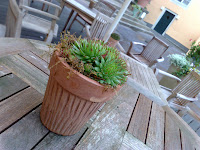December was filled with travel – twice to the US and several trips in Europe – and for the first time in two years I did not really get around to write my blog…
I am still wondering what technology we require that could make physical meetings less important. Video conference is getting better and I use it a lot – but it still does not facilitate a discussion between 30 or more people well. Besides the work that is in reviewing I really emjoy that part of my job – I find it really exciting to see so much (somehow) novel work in a very short time.
 Academics often complain about a lot of travel – but sometimes we need a reality check. Walking around Atlanta airport and seeing the large number of soldiers I felt that I should not complain about my travels… At the same time I asked myself what we will have first: “remote only” wars or “remote only” critical business meeting.
Academics often complain about a lot of travel – but sometimes we need a reality check. Walking around Atlanta airport and seeing the large number of soldiers I felt that I should not complain about my travels… At the same time I asked myself what we will have first: “remote only” wars or “remote only” critical business meeting.
 In the first two weeks of December I had the privilege to be the CHI, Pervasive and PerCom program committee meeting. Having seen more than 100 papers being discussed made the effort in reviewing worthwhile. The overview of the field one gets is amazing. And with the insight view I am looking forward to three very interesting conference programs to come in 2010. By the way Geraldine Fitzpatrick (this years paper co-chair at CHI) has move to the Vienna University of Technology.
In the first two weeks of December I had the privilege to be the CHI, Pervasive and PerCom program committee meeting. Having seen more than 100 papers being discussed made the effort in reviewing worthwhile. The overview of the field one gets is amazing. And with the insight view I am looking forward to three very interesting conference programs to come in 2010. By the way Geraldine Fitzpatrick (this years paper co-chair at CHI) has move to the Vienna University of Technology.
 Besides the PC meetings there was some time to visit labs. In Palo Alto at Nokia Research we were shown a communication appliance that is designed to facilitate remote interaction and communication around a book. Looks interesting and they promised there will be a paper about this soon.
Besides the PC meetings there was some time to visit labs. In Palo Alto at Nokia Research we were shown a communication appliance that is designed to facilitate remote interaction and communication around a book. Looks interesting and they promised there will be a paper about this soon.
 In Boston I went to the new MediaLab building (and met Leah Buechley and Joe Paradiso) – really exciting – research between boxes. Seeing some a Leah’s work motivated again to look more into wearables. If you are curious too, have a look at Lilypad Arduino [1] and at the 2008 CHI paper [2].
In Boston I went to the new MediaLab building (and met Leah Buechley and Joe Paradiso) – really exciting – research between boxes. Seeing some a Leah’s work motivated again to look more into wearables. If you are curious too, have a look at Lilypad Arduino [1] and at the 2008 CHI paper [2].
[1] Buechley, L. Lilypad Arduino | build something. http://web.media.mit.edu/~leah/LilyPad/build.html
 [2] Buechley, L., Eisenberg, M., Catchen, J., and Crockett, A. The Lilypad Arduino: using computational textiles to investigate engagement, aesthetics, and diversity in computer science education. In CHI ’08: Proceedings of the twenty-sixth annual SIGCHI conference on Human factors in computing systems (New York, NY, USA, 2008), ACM, pp. 423-432.
[2] Buechley, L., Eisenberg, M., Catchen, J., and Crockett, A. The Lilypad Arduino: using computational textiles to investigate engagement, aesthetics, and diversity in computer science education. In CHI ’08: Proceedings of the twenty-sixth annual SIGCHI conference on Human factors in computing systems (New York, NY, USA, 2008), ACM, pp. 423-432.













